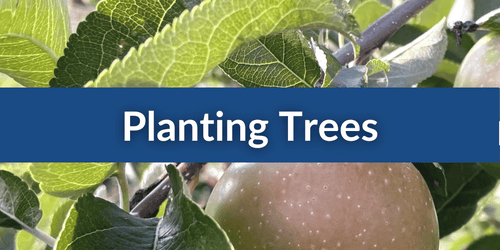

How far apart should I plant my trees?
Trees should ideally be planted about 20 feet apart.
How long will it take for my tree to bear fruit?
4 to 10 years, depending on conditions (sunlight, soil, variety, etc). It’s worth the wait!
Do I need to plant more than one tree?
Apples need a second apple tree of a different variety nearby for pollination–within a quarter mile, but closer is better. Crabapples are fine as a pollinator. Pears, similarly, need a second pear variety nearby for pollination. Asian pears can produce fruit on their own, but bear fruit more reliably with a second Asian pear variety nearby.
Some apple varieties are triploid, which means they can be pollinated by any other apple tree but they are unreliable as a pollinator for other trees. Baldwin is a triploid variety.
How big are the trees? Will they fit in my car?
In general, these 2-year old trees are 4 to 7 ft long, including the roots. The trees are bare-root—no soil or pot—so you can transport them horizontally. They don’t have much side branching and they are bendy, which helps when transporting them. Most 2-year-old trees fit in a hatchback.
How big will the tree be when it’s fully grown?
Apple trees reach 15 to 20 feet when fully grown. Pears and Asian pears will be between 20 and 30 feet tall when mature. You have some amount of control over how big your tree gets by pruning it more/less aggressively.
Is my site good enough to grow a tree?
All fruit trees should get at least half a day of sun (ideally full sun). They like well-drained soil—avoid water-logged areas. They do best in areas with good air flow. They are tolerant of a wide range of soil types, but you should have at least 18 inches of soil for root growth.
When is a good time to plant fruit trees?
The best time to plant trees is in the early spring and the late fall.
Planting your tree, step-by-step:
1. Before planting: soak the tree’s roots in a container of water for one to two hours. This keeps the roots from drying out while you dig the hole. Avoid soaking roots for more than six hours.
2. Do not expose roots to freezing temperatures (or below) prior to planting.
3. Dig the hole deep and wide enough so the root system has plenty of room to grow. A hole 2 ft. in diameter and 2 ft. deep is usually sufficient. Keep the more-nutritious topsoil in a separate pile so you can put it in the bottom of the hole. *If you have heavy soil, you can loosen the soil by thoroughly mixing aged manure, garden compost, or coconut coir (up to 1/3 concentration) into the topsoil.
4. Place the tree in the center of the planting hole with its roots down and spread out. Keeping the trunk vertical, backfill the hole, putting the topsoil back in first. Work the soil carefully around the roots and tamp down firmly as you refill the planting hole around your tree in order to avoid creating air pockets.
5. Create a rim of soil around the planting hole about two inches above ground level. This is called a “berm” and it works to catch water so that it can soak in rather than running off and causing soil erosion. This is especially important if planting on a slope.
Planting your tree, step-by-step:
Before planting: soak the tree’s roots in a container of water for one to two hours. This keeps the roots from drying out while you dig the hole. Avoid soaking roots for more than six hours.

